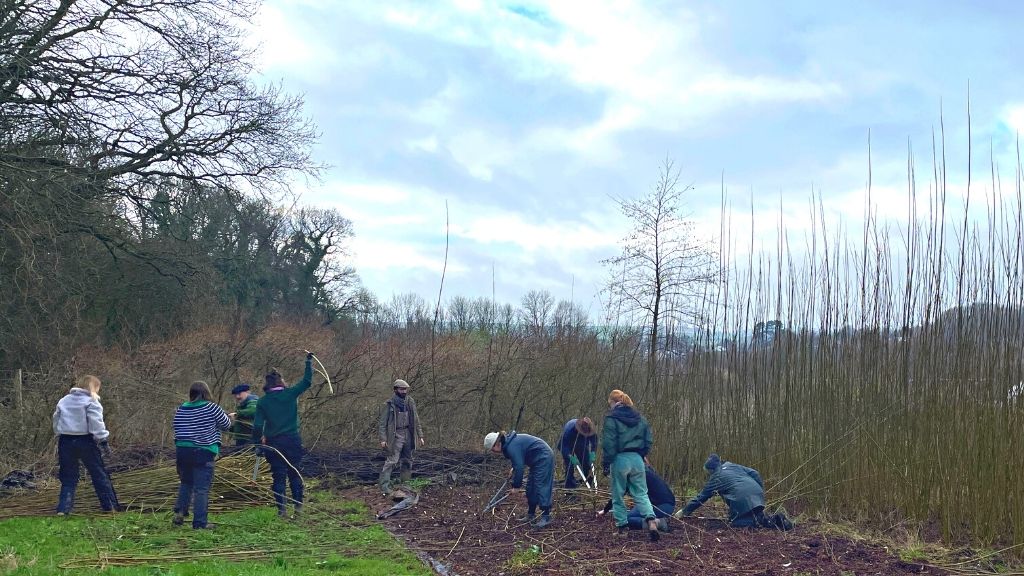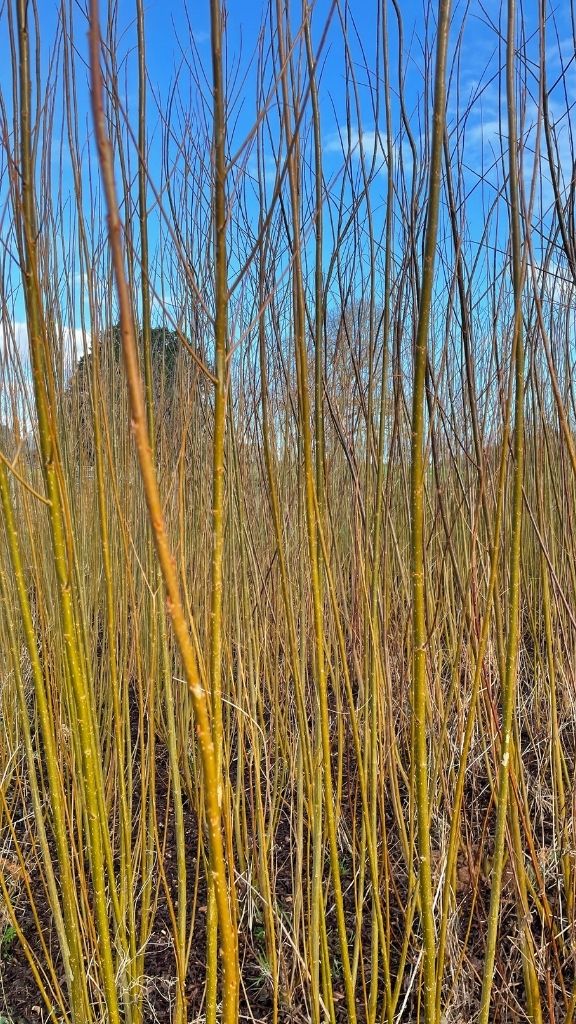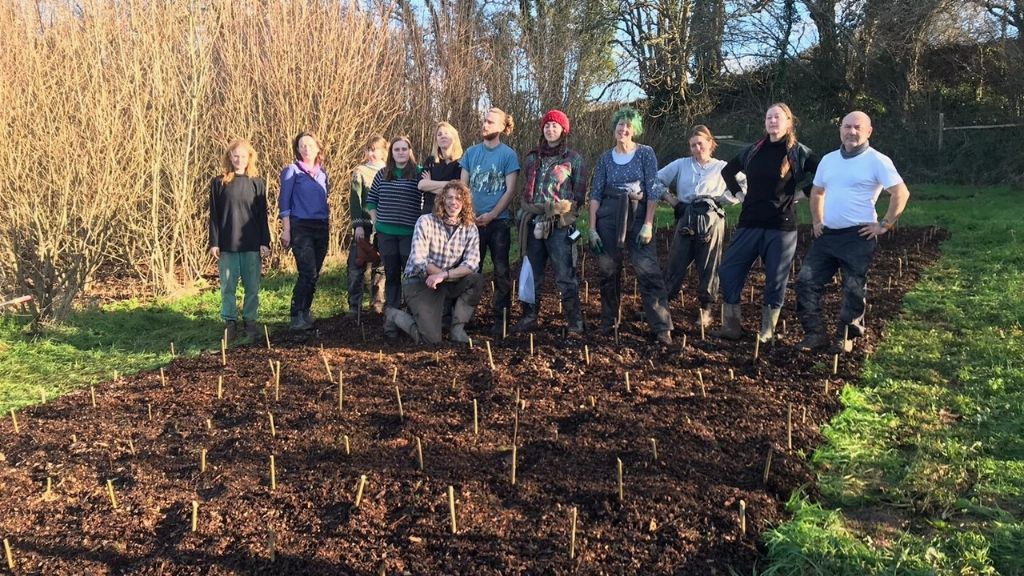Willow Coppicing at Schumacher College

In this blog post we discuss why we’re returning to the almost lost art of coppicing and the ecological and agricultural benefits of this ancient practice… As well as introducing patches in our growing space, we also hold teaching sessions about it on our Regenerative Food and Farming and horticulture programmes.
The practice of coppicing was widely practiced across the British Isles and Europe and has been dated back to the Stone Age. It then fell into decline in the 19th Century as timber was replaced by other resources for building construction and as coal and coke took precedence as the main source of fuel. But in recent years there has been a resurgence in the practice in ecological farms, growing spaces, and conservation areas. We’ve been inspired in part by the work of Ian Tolhurst, who has argued for the reintroduction of this technique to farming as a low impact, cost effective method for improving soil quality. His research has led him to suggest 20% of your growing area needs to be under willow, for woodchipping, so if you had an acre of veg you would want a fifth of an acre of coppice.
The basic idea of coppicing may seem counter intuitive – cutting back trees time and time again – wouldn’t it be better to wait until the tree is more established? But as has been quite well documented now, the fact is coppicing promotes really vigorous growth from the tree, so once it is cut back, it grows back again faster. This can actually end up providing a more sustainable supply of wood, especially if you are using it to make woodchip. Ian Tolhurst has shown us that it is possible to run a farm where, other than green manures, Ramial Chipped Wood from coppicing is the only source of fertility. He reckons that if you grow about a fifth of your growing area under willow, then you could provide enough fertility alongside green manures to be purely self-sufficient in all your inputs so you don’t have to use any livestock in your systems. He’s what’s called veganic, in other words he’s using a purely vegan growing system, using just green manures and Ramial woodchip.
Ian’s work has inspired us here at Dartington and quite a lot of people in the UK. In Henri’s Field, our main growing area at Schumacher College, we have now devoted a reasonable portion of space to coppicing. We’ve introduced our willow plot of 0.13 acres making that 2.6% of the whole field. We’ve gone with willow, though many deciduous trees can be used – you can use coniferous too, but you’d only want to use about 20% of the mix in total. Willow works for us partly because of where we’re growing in Devon. It’s a wet climate and we’re growing in a corner of the field where it’s dark and damp – we wouldn’t be growing much else there and willow loves that kind of space. We’ve got particular types of varieties that have been bred for Biomass. So that means they’re really, really productive, putting on lots of growth every year. So to give you an idea the willow in the video that we were cutting the other day was actually only a year old and then the stuff next to it a year’s growth is 12 – 14 feet per year.

Our aim is to have five patches each planted annually so that we can then coppice each patch every five years – four to five years of growth is ideal. Then we’ll coppice it. And then the next year we’ll move on to the next patch so on each year until after five years we’re back at the first patch and it has grown sufficiently to be ready for coppicing again. A five year cycle like this will provide us with a pretty good supply of woodchip for our needs as a small food producer for the for the café and restaurant at Dartington, the Green Table and White Hart, for feeding our learning community, and then of course for the educational aspect of showing our Regenerative Farming and residential horticulture students how it works in practice.
What will be interesting to see is how the quality of the willow will change as it’s repeatedly coppiced. It’s obviously really tall at the moment and we’re hoping that rather than continuing to grow 15 feet tall every year or so it will grow out in girth a bit more. Otherwise it’s going to be quite an effort to coppice. This kind of willow isn’t going to be so good for things like basket making because it’s already too thick and not flexible enough, but that’s not what we’re using it for. (We do grow basketry willow in our Craft and Cut Flower Garden and run courses in basket-making.)
What do you do with it once you’ve cut it down?
The purpose of coppicing willow in this way is to create Ramial Chipped Wood. Ramial really just essentially corresponds to the size of the wood – between about five and seven centimetre diameter branch wood is ideal. The reason for that is because 75% of all the nutrition and the goodness of the woodchip has to offer your soil is in those younger branches. When it gets bigger than that the ratio between the cambium, the living outer layer of the tree, and the cellulose inside isn’t so favourable. It also takes longer to break down and is less convenient to coppice by hand, as we do here. So if you’re trying this at home you want to cut young wood.
The important thing, we’ve found, is that when you cut it you want to then chip it and apply it to your soil within about the space about six weeks. You want the stuff to still be green, because it will break down faster. Again we’re taking inspiration from Ian Tolhurst and actually add the woodchip to our soil when the soil is already under a green manure. So we’re really adding more fertility at that stage from these two practices. When we come to terminate the green manure and put our crops in afterwards, we also have an extra bit of fertile ground.
Anyone could grow willow. It’s a very fast growing, easily reproduced and can cope in less sunny and damper conditions in places where you couldn’t grow much else. We’ve just taken 30cm long sticks which are stuck in the ground. As you get going of course you can just take cuttings from the trees you’ve just coppiced to continue the cycle. That’s what we’ve just done here.
And then what?

So once we’ve chipped up the willow into biomass then, rather than using it for burning, we use it to feed the soil. In this way we’re adding organic matter and all sorts of nutrients and so on to the soil. On one hand it’s good because we’re sequestering carbon. But this kind of woodchip is also really great for feeding the soil life, encouraging all the microbes or fungi, the bacteria and so on, adding the crucial fertility we need to support the crops we will be growing in there.
We’ve discovered recently that another benefit is that if the PH of your soil is too acidic or too alkaline, adding the Ramial woodchip actually helps to bring the soil back to neutral, in either direction. This is really beneficial as the plants grow best in a more neutral soil.
So, now you know how easy it is why not give it a go in your own growing space? There is research showing that coppiced areas can also help encourage greater biodiversity – small birds and invertebrates possibly benefiting from the protective but not overbearing light cover offered by the young branches. Willow also acts as a fantastic windbreak, so if your space is quite exposed it can provide good protection if grown in strips, in a similar way to how we have grown our apple trees in strips with beds in between. There may also be substantial economic benefits, which you can read more about at the Organic Research Centre via this link.
Written by Colum Pawson and Will Kemp
We offer various study pathways for anyone interested in learning about agroecological techniques and practices just like this in more detail and in practice. Click the links below to explore and apply.
